 1959 DeSoto Firesweep I 4-Door Sedan (facelift 1959) Dimensions, Size & Specs
1959 DeSoto Firesweep I 4-Door Sedan (facelift 1959) Dimensions, Size & Specs
Measurements of the 1959 DeSoto Firesweep I 4-Door Sedan, engineered for optimal performance and comfort
| Dimensions | |
|---|---|
| Length: | 5514 mm217.1 in18.1 ft |
| Width: | 1999 mm78.7 in6.6 ft |
| Height: | 1443 mm56.8 in4.7 ft |
| Ground Clearance: | 140 mm5.5 in0.5 ft |
| Weight Specifications | |
| Curb Weight: | 1735 kg3825 lbs |
The 1959 DeSoto Firesweep I 4-Door Sedan represents a classic example of late 1950s American full-size cars, showcasing the brand's characteristic bold styling and spacious design. Produced between 1958 and 1959, the Firesweep I facelift version of 1959 features a substantial body size with a length of 5514 mm (217 inches), a width of 1999 mm (78.7 inches), and a height measuring 1443 mm (56.8 inches). These dimensions emphasize its status as a roomy sedan, built to comfortably fit five to six passengers with generous interior space typical of the era. Weighing in at approximately 1735 kg (3827 lbs), the Firesweep I carries a relatively hefty curb weight, contributing to a stable and smooth ride, which was a priority in cars from this period. The ride height or ground clearance stands at 140 mm (5.5 inches), balancing the higher stance of sedans from the 1950s with road clearance sufficient for typical driving conditions of its time. Overall, the 1959 DeSoto Firesweep I 4-Door Sedan is a strong representation of mid-century American automotive craftsmanship, combining robust dimensions, elegant design cues from its facelift, and comfortable proportions. This car remains a notable model for enthusiasts interested in classic full-size sedans, highlighting both its size and aesthetic appeal in a competitive era of car manufacturing.
Discover the standout features that make the 1959 DeSoto Firesweep I 4-Door Sedan a leader in its class
Have a question? Please check our knowledgebase first.
The 1959 DeSoto Firesweep I 4-Door Sedan measures 5514 mm (217 inches) in length, 1999 mm (78.7 inches) in width, and 1443 mm (56.8 inches) in height. These generous dimensions reflect the car's full-size sedan status typical of late 1950s American automobiles. The width approaching 2 meters provides a spacious cabin interior, while the length offers ample passenger and trunk space.
The curb weight of the 1959 DeSoto Firesweep I 4-Door Sedan stands at approximately 1735 kilograms (3826 pounds). This weight is moderate for a full-size sedan of the era and influences both fuel consumption and handling characteristics. The substantial mass contributes to a stable, comfortable ride but means the engine needs to work robustly to provide responsive acceleration. Given the technology of the time, the engine and suspension were tuned to balance power and ride comfort effectively.
Standard residential garages generally measure around 2438 mm to 2743 mm (8 to 9 feet) in width and about 5182 mm (17 feet) in length. The 1959 DeSoto Firesweep I measures 5514 mm (217 inches) long and nearly 2 meters wide (1999 mm or 78.7 inches). While it fits lengthwise with some clearance, the width is close to the limits of standard single garages, potentially requiring careful maneuvering. Owners may find it fits comfortably in most two-car garages or larger garages designed for full-size vehicles.
This Firesweep sedan features a ride height or ground clearance of 140 mm (5.5 inches), which is typical for sedans from the late 1950s. This clearance is sufficient for urban and suburban roads of that time while balancing passenger comfort and road handling. While not designed for off-road use, this ground clearance helped the vehicle negotiate common road obstacles like speed bumps and uneven pavement without scraping the underbody.
With a width just shy of 2 meters (1999 mm / 78.7 inches) and an overall length of 5514 mm (217 inches), the Firesweep I Sedan offers considerable interior space typical of late '50s American sedans. Although exact interior measurements are not specified, the broad width translates into comfortable seating for five adults, with ample shoulder room and legroom. The large footprint also supports a spacious trunk area, making it a practical choice for families and travelers.
At about 1735 kg (3826 lbs), the Firesweep I is relatively heavy by today's standards but typical in its era. This weight impacts fuel efficiency negatively, as heavier vehicles require more energy to move. However, the cars of this period were built to prioritize ride comfort and steady handling over fuel economy. The substantial weight contributes to a smooth ride, reducing the sensation of bumps and bumps, but it can make the vehicle less agile compared to lighter cars, especially in tight cornering.
The Firesweep I has a height of 1443 mm (56.8 inches) and a width of 1999 mm (78.7 inches), making it relatively low and wide. The lower height contributes to a sleek profile which improves aerodynamics slightly and provides a sportsier look compared to taller sedans. The broad width offers excellent shoulder room but can make parking in tight spots more challenging. Driver visibility is aided by the large windshield and spacious cabin, although the wider stance requires careful attention in narrow urban settings.
The predecessor to the 1959 Firesweep I was produced in 1957-1958 and shared similar body designs but with some changes introduced in the 1959 facelift. Dimensionally, the 1959 model retained a similar length and width; however, styling updates improved aerodynamics and visual appeal. Performance-wise, the 1959 model often featured updated engines and suspension tuning for better ride quality and reliability. Overall, while the size remained consistent, the facelift brought subtle improvements in comfort and drivability.
Compared to contemporaries like the Chevrolet Bel Air, Ford Galaxie, or Chrysler Newport, the 1959 DeSoto Firesweep I sedan is competitive in size, with its length of 5514 mm (217 inches) and width of nearly 2 meters (78.7 inches). The Firesweep offers comparable passenger space and road presence, often with more elaborate styling cues typical of DeSoto’s design language. Feature-wise, it balanced spacious interior comfort, moderate ground clearance, and solid construction, placing it comfortably in the upper tier of full-sized American sedans of its era.
The 1959 facelift on the DeSoto Firesweep I marked an important update that kept the model fresh in a competitive marketplace. The changes typically included revised front and rear styling elements such as new grille designs, headlight arrangements, and tail fins, which were key styling trends in the late '50s. These updates helped maintain consumer interest in the model by aligning with evolving tastes toward more modern, sleek, and expressive car designs. Additionally, mechanical and trim improvements often accompanied the facelift to enhance performance and luxury appeal.
Discover similar sized cars.
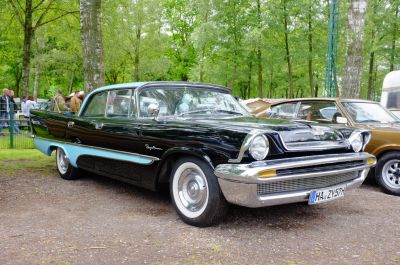
| Production: | 1956-1957 |
|---|---|
| Model Year: | 1957 |
| Length: | 5481 mm215.8 in |
| Width: | 1986 mm78.2 in |
| Height: | 1440 mm56.7 in |
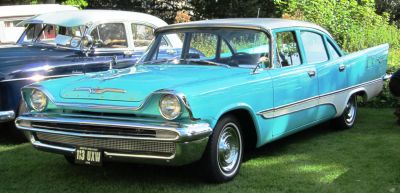
| Production: | 1956-1957 |
|---|---|
| Model Year: | 1957 |
| Length: | 5481 mm215.8 in |
| Width: | 1986 mm78.2 in |
| Height: | 1440 mm56.7 in |
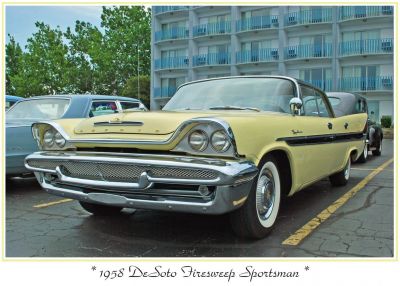
| Production: | 1957-1958 |
|---|---|
| Model Year: | 1958 |
| Length: | 5499 mm216.5 in |
| Width: | 1989 mm78.3 in |
| Height: | 1443 mm56.8 in |
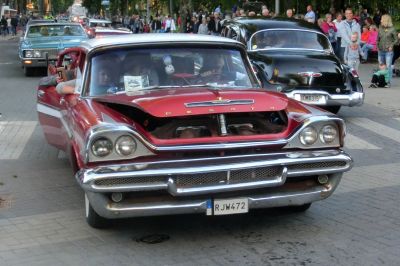
| Production: | 1957-1958 |
|---|---|
| Model Year: | 1958 |
| Length: | 5499 mm216.5 in |
| Width: | 1989 mm78.3 in |
| Height: | 1443 mm56.8 in |
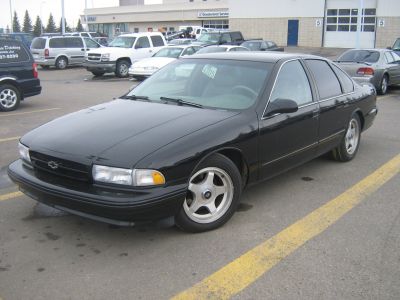
| Production: | 1994-1996 |
|---|---|
| Model Year: | 1994 |
| Length: | 5439 mm214.1 in |
| Width: | 1968 mm77.5 in |
| Height: | 1415 mm55.7 in |
